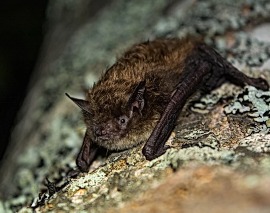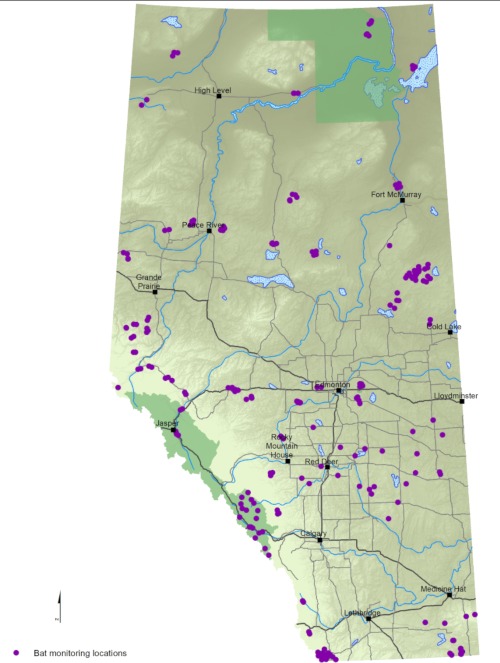NABat
Standardized, coordinated bat monitoring for Alberta.

What is NABat?
NABat is a multinational, multi-agency coordinated bat monitoring program across North America made up of an extensive community of partners. Partners use standardized protocols at sites (or “stations”) located in predetermined 10 km x 10 km grid cells to gather data as well as other bat survey types. Data are used to assess population status and trends, help understand how bats respond to stressors, and help sustain viable populations.
What is the NABat Alberta Monitoring Hub?
The NABat Alberta Monitoring Hub is a collaborative initiative led by bat researchers at the University of Alberta, Alberta Environment and Parks, Parks Canada, and the Alberta Biodiversity Monitoring Institute.
The group’s mission is to develop and operate a coordinated approach to bat data collection and management across the province and develop a centralized bat data hub for provincial data. Provincial data are then shared with the broader NABat program.
For more information about the hub and how to get involved, please contact Monica Kohler (mkohler@ualberta.ca) and Lisa Wilkinson (lisa.wilkinson@gov.ab.ca).
Bat Monitoring
Nine species of bats occur in Alberta. Three species are resident during the summer and migrate south during the winter. Six species are resident during the summer and hibernate during the winter.
Stationary acoustics are one of the survey types that NABat uses to collect and collate data. We use ultrasonic bat detectors to record bat sounds and follow the standard monitoring program outlined by NABat. The Alberta Bat Hub is currently monitoring approximately 20 NABat stations annually. In addition, members of the Alberta hub operate targeted bat research programs to address scientific questions about bats, and participate in coordinated efforts to monitor bat health and productivity (Figure 1). By working collaboratively, our group is increasing the amount of data available on bats in the province.
Figure 1: Bat survey locations in Alberta surveyed in 2021 by members of the Alberta Bat Hub.
Sharing and Accessing Alberta Data
Openly available, standardized data on bats help:
● facilitate knowledge sharing among bat researchers;
● maximize the value of data being collected;
● increase the efficiency of bat data management, processing, and sharing, (including data contribution to NABat program); and
● support data-driven solutions to wildlife conservation and management.
Alberta Bat Hub data will be housed on the WildTrax data platform for environmental sensors and are slated for public release in 2023, with the goal of contributing data to the broader NABat program. The Alberta Bat Hub aims to maximize data availability to support provincial, national, and international assessments.
Annual Reports
Final annual reports for Alberta’s North American Bat Monitoring Program are available online: albertaebat.ca
Additional Resources
Interested in learning more about Alberta’s bats? Check out the Alberta Community Bat Program for information about the bats that call Alberta home and how you can get involved in broader bat initiatives: https://www.albertabats.ca/
An instructional video series on bat monitoring was developed by the Canadian Wildlife Health Cooperative, Atlantic Region. Topics span the basics of bat biology and echolocation to deploying bat detectors in the field to data management.
NABat's resource page houses instructions for the NABat workflow, from project planning to data quality control. There is also an extensive library of training videos available online.
Partners





